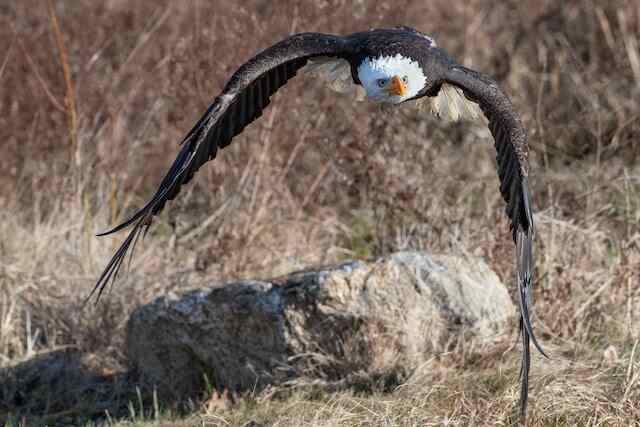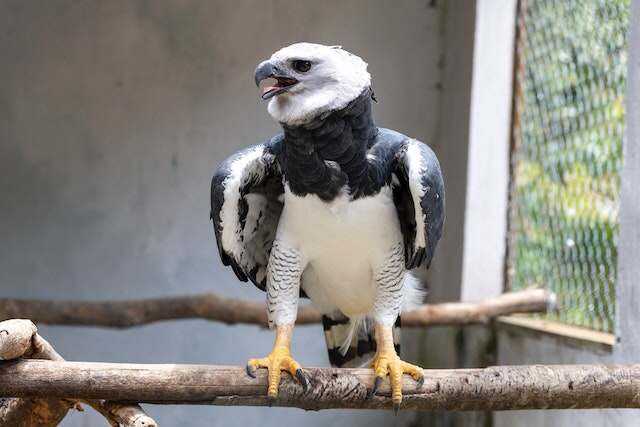Can Eagles Kill Humans? Majestic birds of prey, eagles have captured the human imagination for centuries. With powerful wingspans, sharp talons, and keen eyesight, they dominate their habitat as apex predators.
While not known for actively hunting humans, understanding their behavior and habitat is crucial to assessing the risk of eagle attacks.
Found worldwide, eagles exhibit aggressive territorial behavior, defending nests and hunting grounds. While they primarily feed on small prey, they have been known to target larger animals.
Join us as we explore whether humans could be potential targets for these awe-inspiring creatures.
Table of Contents
- 1 Key Takeaways
- 2 Overview of Eagle Behavior and Habitat
- 3 Can Eagles Kill Humans
- 4 Factors that can lead to Eagle Attacks
- 5 Types of Eagles and their Characteristics
- 6 Eagle Hunting and Feeding Habits
- 7 Safety Tips for Avoiding Eagle Attacks
- 8 Understanding Eagle Body Language
- 9 What to do if Attacked by an Eagle
- 10 Eagle Conservation Efforts
- 11 Eagle Myths and Legends
- 12 Eagle Symbolism in Culture
- 13 Frequently Asked Questions
- 14 Conclusion
- 15 Author
Key Takeaways
- Eagles have powerful beaks, talons, and eyesight, which they use for hunting and defending their territory.
- Approaching too closely to an eagle’s nest or hunting territory can lead to potential attacks, especially during breeding season.
- Respecting eagle’s natural habitats and maintaining a safe distance from their nests is crucial for their protection and promotion of their continued survival.
- Disturbing eagle nests can lead to a disruption in their reproductive cycle and affect their population, ultimately leading to their extinction.
Overview of Eagle Behavior and Habitat
The behavior and habitat of eagles play a crucial role in understanding their predatory tendencies and potential threats to human safety.
Eagles are known for their impressive hunting and predatory skills, and they typically inhabit areas with open spaces and plentiful prey.
One important factor to consider is eagle migration patterns, as they may move to new areas in search of food or breeding opportunities.
Additionally, eagle breeding behavior can impact their behavior and aggression levels, as they become territorial and protective of their nests and offspring.
Understanding these factors can help us better understand the potential for eagle attacks on humans and how to minimize the risks.
Can Eagles Kill Humans
While rare, there have been instances where eagles have attacked humans, causing injuries or even fatalities. Eagles are powerful birds of prey with sharp talons and strong beaks, capable of inflicting harm.
However, such attacks are usually defensive in nature, aimed at protecting their territory or nests. It’s important to note that eagles do not actively hunt humans as prey.
Understanding eagle behavior, respecting their territory, and following safety guidelines can help minimize the risk of such incidents.
Factors that can lead to Eagle Attacks
One of the primary factors contributing to potential attacks by these birds of prey is the intrusion into their territory or nesting sites.
Eagles are known for being territorial creatures and can become aggressive towards humans if they feel threatened or disturbed.
It’s important to note that not all eagles are the same, and their behavior can vary depending on their species and habitat.
For instance, bald eagles tend to nest near water bodies and can become aggressive if humans get too close to their nests.
Golden eagles, on the other hand, are known to attack small mammals and may mistake humans for prey if they are in their hunting territory.
Precautionary measures such as avoiding known eagle habitats, keeping a safe distance, and not disturbing their nests can help to prevent attacks.
Understanding eagle habitats and behavior can also help humans to avoid potential confrontations. In the next section, we will discuss the types of eagles and their characteristics.
Types of Eagles and their Characteristics
Various species of these birds of prey possess distinctive characteristics and behaviors, which can be identified by ornithologists and other experts in the field.
Eagles are a diverse group of birds, with over 60 species found across the globe.
They range in size from the diminutive South Nicobar Serpent Eagle, which weighs only 450 grams, to the mighty Harpy Eagle, which can weigh up to 9 kilograms.
Eagles have large, hooked beaks that are used to tear apart their prey, and powerful talons that can grip and kill prey with ease.
They also have excellent eyesight, with some species able to see prey from over 3 kilometers away.
Additionally, eagles are known for their aerial acrobatics, which they use to catch prey in mid-air or to evade predators.
Understanding the diversity of eagle species and their physical characteristics is crucial to understanding their behavior and potential interactions with humans.
Moving forward, it is important to also consider the hunting and feeding habits of eagles to fully comprehend their role in the ecosystem.
Eagle Hunting and Feeding Habits
Understanding the hunting and feeding habits of these magnificent birds is crucial to gaining a deeper insight into their ecological role and behavior.
Eagles are known for their exceptional hunting skills and have developed various techniques to capture their prey.
Some eagles, such as the bald eagle, will hunt fish by diving and snatching them from the water’s surface, while others, like the golden eagle, will hunt larger prey such as rabbits and small mammals by swooping down and grabbing them with their talons.
Prey preferences vary among eagles, with some species preferring fish, while others hunt birds or small mammals.
Eagles are also opportunistic feeders and will scavenge for food if necessary. It’s important to note that eagles are not typically a threat to humans, and attacks are rare.
However, understanding their behavior is important for safety reasons.
| Eagle Species | Hunting Techniques | Prey Preferences | Habitat |
|---|---|---|---|
| Bald Eagle | Diving and snatching fish from water | Fish | Near water sources such as rivers, lakes, and coasts |
| Golden Eagle | Swooping down and grabbing prey with talons | Small mammals such as rabbits and rodents | Mountainous regions and open areas with high visibility |
| Harpy Eagle | Ambushing prey from perches in trees | Birds and mammals such as monkeys and sloths | Tropical rainforests and lowland forests |
| White-tailed Eagle | Diving into water to catch fish | Fish and birds | Coastal regions and near large bodies of water |
To avoid potential attacks, it’s important to understand safety tips for interacting with eagles in their natural habitats.
Safety Tips for Avoiding Eagle Attacks
When it comes to eagle attacks, prevention is always better than cure. To avoid such incidents, it is important to respect the eagle’s territory and avoid disturbing their nests.
Additionally, keeping a safe distance from these birds of prey is crucial, especially when they are hunting or when you come across a sick or injured eagle.
By following these safety tips, we can minimize the risk of eagle attacks and coexist safely with these magnificent creatures.
Respect their Territory
Respecting the territory of eagles is crucial for avoiding potential conflicts between humans and these powerful predators.
It is important to understand that eagles are territorial creatures and will fiercely protect their nests and hunting grounds.
To avoid disturbing their habitat, it is essential to educate oneself about eagle behavior and habitat.
Responsible tourism is also crucial in preserving the natural environment and allowing eagles to thrive. To evoke emotion in the audience, consider the following table:
| Human Behaviors | Eagle Reactions |
|---|---|
| Entering nesting areas | Aggressive behavior such as swooping and diving |
| Disturbing hunting grounds | Fierce territorial defense |
| Approaching too closely | Intimidation displays such as vocalizations and wing flapping |
By respecting eagle territory, humans can coexist with these majestic creatures and enjoy their presence without fear of conflict. Avoiding disturbance of nests is another important step in maintaining a peaceful relationship with eagles.
Avoid Disturbing Nests
Preserving the integrity of eagle nests is vital for maintaining a safe and healthy environment for these majestic birds of prey, as well as for promoting biodiversity.
Any disturbance to these nests can lead to a disruption in the eagle’s reproductive cycle, ultimately affecting their population.
Human disturbance, whether intentional or accidental, can cause eagles to abandon their nests, which can reduce their chances of survival.
Therefore, it is crucial to avoid disturbing eagle nests at all costs.
This can be achieved by keeping a safe distance from the nests, refraining from loud noises or sudden movements, and avoiding any activities that may disrupt the natural habitat around the nest.
By protecting the eagle’s nests, we can ensure that these magnificent birds continue to thrive, and our environment remains healthy and balanced.
Keep a Safe Distance
Maintaining a safe distance from eagle nests is essential to ensure their protection and promote their continued survival in their natural habitat.
To avoid disturbing these majestic birds, it is important to take protective measures and keep a safe distance from their nests.
Eagles are powerful predators and can become aggressive if they feel threatened, especially during breeding season.
Approaching too closely or disturbing their nests can lead to the abandonment of eggs or young, which can have negative impacts on the entire population.
Therefore, it is crucial to respect their space and observe them from a distance.
In the next section, we will discuss another important aspect of eagle safety: not approaching injured or sick eagles.
Do Not Approach Injured or Sick Eagles
Approaching injured or sick eagles can be dangerous, as they may try to defend themselves.
It is important to understand that eagles, like any wild animal, are not domesticated and may react aggressively when threatened or approached.
Therefore, if you come across an injured or sick eagle, it is best to contact a professional wildlife rehabilitator or a licensed wildlife removal expert for assistance in handling eagles.
These experts have the necessary skills and equipment to handle eagles safely and effectively, without causing harm to the bird or to humans.
Additionally, seeking professional help will also ensure that the eagle receives the proper care it needs for rehabilitation and eventual release back into the wild.
Understanding eagle body language is also important in recognizing their behavior and avoiding any potential danger.
Understanding Eagle Body Language
Interpreting eagle body language can provide valuable insight into their behavior and potential threats to humans.
Eagle communication involves a variety of gestures and sounds that can indicate aggression or territoriality, such as fluffing up feathers, vocalizing loudly, or diving towards perceived threats.
Understanding eagle social behavior, including their mating and parenting dynamics, can also provide important context for interpreting their body language.
However, it is important to remember that eagles are wild animals and their behavior can be unpredictable.
If attacked by an eagle, it is important to stay calm and protect your head and neck.
What to do if Attacked by an Eagle
Understanding eagle body language is essential in preventing potential attacks by these magnificent birds of prey.
However, if one finds themselves in a situation where they are being attacked by an eagle, it is crucial to know how to defend oneself.
The first step is to protect one’s head and neck, as these are the areas that eagles typically target. One can also use an umbrella, jacket, or any object to fend off the eagle.
It is important to note that eagles attacking humans is a rare occurrence, and any sightings should be reported immediately to local authorities and conservation organizations.
In addition to self-defense, reporting sightings helps with conservation efforts, as it aids in monitoring and protecting eagle populations.
Despite their power and strength, eagles are a vital part of our ecosystem and must be protected.
Moving forward, let us explore the various conservation efforts being made to ensure the survival of these magnificent birds.
Eagle Conservation Efforts
The eagle population has been declining over the years due to various factors such as habitat destruction, hunting, and pollution.
To combat this, numerous conservation strategies have been implemented, including habitat protection, awareness campaigns, community involvement, and government policies.
These efforts have led to an increase in the eagle population in some areas, but more work needs to be done to ensure their survival.
Awareness campaigns have been successful in educating the public about the importance of eagles and their habitat.
Community involvement has also been crucial in protecting eagle habitats.
Government policies have played a vital role in protecting eagle populations by enacting laws and regulations to prevent hunting and destruction of their habitats.
In conclusion, eagle conservation efforts are ongoing, and it is essential to continue protecting their habitats and raising awareness to ensure their survival.
With these efforts, we can help dispel myths and legends surrounding eagles and promote a better understanding of their importance in nature.
Eagle Myths and Legends
Eagle conservation efforts have been instrumental in protecting the majestic birds and ensuring their survival.
However, eagles have been the subject of many myths and legends throughout history. They have been revered as symbols of strength, power, and freedom in many cultures.
Despite their cultural significance, there have been instances of eagle attacks on humans, causing concern for safety.
To minimize the risk of such attacks, it is important to follow safety tips, such as avoiding areas where eagles are nesting or feeding.
In addition, understanding the myths and legends surrounding eagles can deepen our appreciation for these magnificent creatures and their place in our cultural history.
In the following section, we will explore the cultural significance of eagles and their symbolism in various cultures.
Eagle Symbolism in Culture
Across different cultures, the eagle serves as a symbol of various virtues and characteristics, embodying strength, wisdom, and spirituality.
In literature, eagles have been used to represent freedom and independence, often depicted as soaring high above the earth with powerful wings.
Similarly, in religion, eagles are associated with divine power and protection, often seen as messengers of the gods.
In Native American culture, eagles are revered as sacred animals, representing a connection to the spiritual world and serving as symbols of courage and wisdom.
The eagle’s symbolism in culture has been passed down through generations, inspiring people to strive for greatness and reminding us of the power and majesty of nature.
Frequently Asked Questions
What is the average lifespan of an eagle?
The average lifespan of an eagle varies by species and geographic location, with some living up to 30 years. Habitat preservation is crucial for maintaining eagle populations and ensuring their longevity.
How do eagles communicate with each other?
Eagles communicate with each other through a variety of hunting techniques and vocalization patterns. They use high-pitched whistles and screams to establish territory and attract mates. Their communication helps ensure successful hunting and breeding, key components of their survival and freedom in the wild.
What is the largest eagle species in the world?
The largest eagle species in the world is the Philippine Eagle (Pithecophaga jefferyi), which can reach a length of up to 3.3 feet and a wingspan of up to 7 feet. Unfortunately, eagle conservation is threatened by habitat destruction and other human-related activities.
Do eagles mate for life?
Eagles are known for their monogamous breeding habits, with courtship behavior and parental roles playing a significant role in their mating process. These majestic birds exhibit complex behaviors that are fascinating to observe, making them a subject of interest for many people.
How many eggs do eagles typically lay in a clutch?
On average, eagles lay 1 to 3 eggs per clutch. Eagle egg incubation lasts for about 35 days, with hatching occurring over a period of a few days. This information is important for understanding eagle reproduction and population dynamics.
Conclusion
In conclusion, while eagles are known for their majestic beauty and impressive hunting skills, they are not typically a threat to humans.
It is extremely rare for an eagle to attack a person, and even when it does happen, it is usually a result of the person encroaching on the eagle’s territory or threatening its young.
Despite their fearsome reputation, eagles play an important role in maintaining the delicate balance of their ecosystems.
Through conservation efforts and increased awareness, we can ensure that these magnificent birds continue to thrive in the wild and inspire us with their grace and power.
As we continue to learn more about these fascinating creatures, we can deepen our appreciation for their place in the natural world and their enduring symbolism in human culture.







